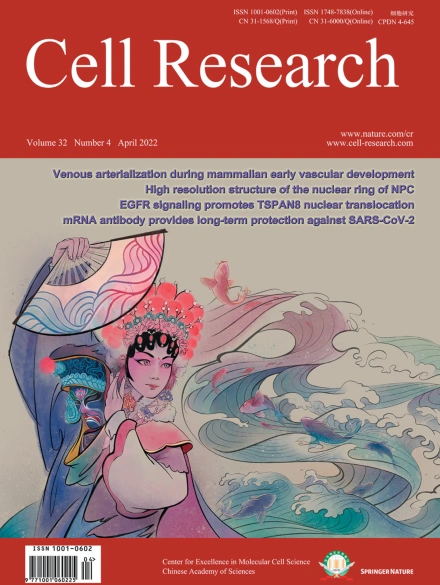
Advanced Search
Submit Manuscript
Advanced Search
Submit Manuscript
Volume 32, No 4, Apr 2022
ISSN: 1001-0602
EISSN: 1748-7838 2018
impact factor 17.848*
(Clarivate Analytics, 2019)
Volume 32 Issue 4, April 2022: 411-414
Structural basis for the gating modulation of Kv4.3 by auxiliary subunits
Demin Ma1,2,† , Cheng Zhao1,† , Xiaochen Wang3 , Xiaoxiao Li1 , Yi Zha1 , Yan Zhang1 , Guosheng Fu2 , Ping Liang3,* , Jiangtao Guo1,2,4,5,6,* , Dongwu Lai2,*
1Department of Biophysics, and Department of Pathology of Sir Run Run Shaw Hospital, Zhejiang University School of Medicine, Hangzhou, Zhejiang, ChinaDear Editor,
Kv4.3 is an A-type voltage-gated potassium channel that is characterized by fast activation at subthreshold membrane potentials, rapid inactivation, and quick recovery from inactivation.1 In neurons, Kv4.3 conducts the transient subthreshold somatodendritic A-type potassium current (ISA), knock down of which results in neuropathic pain and epilepsy.2 In cardiomyocytes, Kv4.3 generates the transient outward potassium current (Ito) and its dysfunction is related to a variety of heart diseases, such as hypertrophy, heart failure, myocardial infarction, heart valvular disease, atrial fibrillation, and diabetic cardiomyopathy.3 Kv4.3 is regulated by accessory subunits Kv Channel-Interacting Proteins (KChIPs) and Dipeptidyl-Peptidase-Like-Proteins (DPLPs). KChIPs are calcium-binding proteins that belong to the neuronal calcium sensor superfamily (NCS). Among four KChIPs (KChIP1–4) in humans, KChIP1 is predominantly expressed in the brain whereas KChIP2 is abundant especially in the heart.4 DPLPs are type II transmembrane proteins with a large extracellular domain (ECD). Two DPLPs, namely DPP6 and DPP10, have been identified as auxiliary subunits of Kv4.3.5 KChIPs and DPLPs regulate the gating kinetics, cell surface expression, and subcellular localization of Kv4.3. At present, how KChIPs and DPLPs bind Kv4.3 and regulate its gating properties remains elusive, due to the lack of high-resolution structures of Kv4.3-KChIP and Kv4.3-DPLP complexes.
https://doi.org/10.1038/s41422-021-00608-4